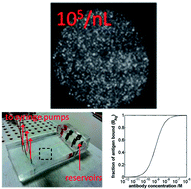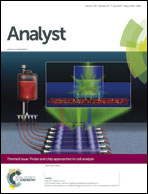Absolute quantification of protein copy number using a single-molecule-sensitive microarray†
Abstract
We report the use of a microfluidic microarray incorporating single molecule detection for the absolute quantification of protein copy number in solution. In this paper we demonstrate protocols which enable calibration free detection for two protein detection assays. An EGFP protein assay has a limit of detection of <30 EGFP proteins in a microfluidic analysis chamber (limited by non-specific background binding), with a measured limit of linearity of approximately 6 × 106 molecules of analyte in the analysis chamber and a dynamic range of >5 orders of magnitude in protein concentration. An antibody sandwich assay was used to detect unlabelled human tumour suppressor protein p53 with a limit of detection of approximately 21 p53 proteins and a dynamic range of >3 orders of magnitude. We show that these protocols can be used to calibrate data retrospectively to determine the absolute protein copy number at the single cell level in two human cancer cell lines.

- This article is part of the themed collection: Probe and chip approaches to cell analysis

 Please wait while we load your content...
Please wait while we load your content...